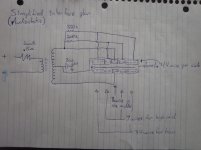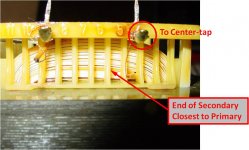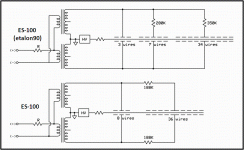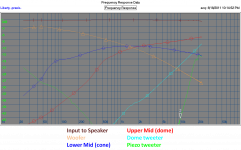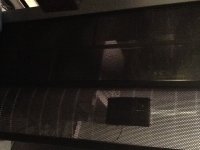HI
I'm currently cogitating with the idea of adding a tweeter over my ESL speaker (audiostatic ES100)
I measured them and they start to drop at about 17K
the plan is to put the Raal as supetweeter on the top crossed at about 17K with a 2nd order or steeper slope on it.
I was also considering the townshend and the tannoy supertweeter but the Raal seem to be my best option. and the later 2 have no data available...
I try to decide between the 140-15d and the 70-10 (price is not a deciding factor)
From raal website, the 150-15d is very flat above 10K
RAAL 140-15D
Madisound confirm with their measurement
The Madisound Speaker Store
But when it come to the smaller 70-10, thing get confusing
the raal website show a very flat curve above 10K
RAAL 70-10
But madisound show a very different one
The Madisound Speaker Store
HOw come they show a 10Db drop
who is to belive?
I'm leaning toward the bigger 140-15d just cause the curve show a flatter response but I wonder if madisound just have some measurement artefact.
Maybe Raal does hide that drop with some smoothing
Anyone have an idea?
Wich one would you pick?
Thanks
I'm currently cogitating with the idea of adding a tweeter over my ESL speaker (audiostatic ES100)
I measured them and they start to drop at about 17K
the plan is to put the Raal as supetweeter on the top crossed at about 17K with a 2nd order or steeper slope on it.
I was also considering the townshend and the tannoy supertweeter but the Raal seem to be my best option. and the later 2 have no data available...
I try to decide between the 140-15d and the 70-10 (price is not a deciding factor)
From raal website, the 150-15d is very flat above 10K
RAAL 140-15D
Madisound confirm with their measurement
The Madisound Speaker Store
But when it come to the smaller 70-10, thing get confusing
the raal website show a very flat curve above 10K
RAAL 70-10
But madisound show a very different one
The Madisound Speaker Store
HOw come they show a 10Db drop
who is to belive?
I'm leaning toward the bigger 140-15d just cause the curve show a flatter response but I wonder if madisound just have some measurement artefact.
Maybe Raal does hide that drop with some smoothing
Anyone have an idea?
Wich one would you pick?
Thanks
I'm currently cogitating with the idea of adding a tweeter over my ESL speaker (audiostatic ES100). I measured them and they start to drop at about 17K
Could you describe or provide a schematic for your ESL including segmentation resistances?
In a previous thread you were discussing modifying an Audiostatic.
http://www.diyaudio.com/forums/planars-exotics/210053-calling-esl-expert.html#post2970687
Perhaps there will be a way to adjust your ESL to avoid the need for adding a tweeter.
In all of the ES-100 loudspeaker pairs I have worked on there was a 5 ohm resistor in series with the primary.
Reducing this resistance to 2 ohm raised up the drooping top end.
HEre a simplified schematic of the interface
I used a 0.15ohm primary side resistor.
stock was 1.8ohm.
Sound is much clearer with the low value one.
HF extension improved a bit. though not much.
With the shown value, I do a very flat 160 to 17k.
I could go as low as 38 with differents value but the overal frequency response wasn't very flat. Moreover, dynamic compression was limiting my max spl.
I high pass the esl at 150 and there, 2 12inch servo subs takes over.
Shown picture is giving me most accurate sound.
I used a 0.15ohm primary side resistor.
stock was 1.8ohm.
Sound is much clearer with the low value one.
HF extension improved a bit. though not much.
With the shown value, I do a very flat 160 to 17k.
I could go as low as 38 with differents value but the overal frequency response wasn't very flat. Moreover, dynamic compression was limiting my max spl.
I high pass the esl at 150 and there, 2 12inch servo subs takes over.
Shown picture is giving me most accurate sound.
Attachments
HEre a simplified schematic of the interface
Calculated capacitive load at 20Khz for your parallel driven 3-segment is a little higher than the stock 2-segment arrangement, but probably not enough to account for the bandwidth reduction you describe.
Hmmmm...Are you using the ES-100 transformers still mounted on their PCboard?
If not, is it possible that you have the wrong ends of the secondary connected for the center-tap? To minimize capacitive load on the secondary, it is important to connect the center tap to the ends of the secondary that are closest to the primary. See attached pic.
This may be of interest...ticknpop added some ribbons to his Martin Logan CLX.
http://www.diyaudio.com/forums/planars-exotics/181041-my-2-nd-esl-attempt-9.html#post2528859
.
Attachments
Last edited:
Factory, my ESL had 4 wires for the hf (4 in front and 4 in back)
I reduced it to 3.
the remainer was 40 wires for the bass and mid all together (40front, 40 back)
I went from 2 to 3 sections with few trial and error to my optimum wich is 3,7,34.
Factory had I think 12K going to the hf and 160K on the bass. (Need confirmation, it is only from memory)
I went to zero on the hf and tried quite of combinaison for the other 2 segregated parts to archive best tonal balance.
My transformer are still on the pcb board and I can't see the side.
I may upgrade them to plitron but does not know if it is worth it.
I went ahead and ordered a pair of RAAL 70-10.
Should have them next week.
Can't wait to play with them and find how sound will become.
bolserst, do you use 3rd or 4rd order for your ribbon?
Martin
I reduced it to 3.
the remainer was 40 wires for the bass and mid all together (40front, 40 back)
I went from 2 to 3 sections with few trial and error to my optimum wich is 3,7,34.
Factory had I think 12K going to the hf and 160K on the bass. (Need confirmation, it is only from memory)
I went to zero on the hf and tried quite of combinaison for the other 2 segregated parts to archive best tonal balance.
My transformer are still on the pcb board and I can't see the side.
I may upgrade them to plitron but does not know if it is worth it.
I went ahead and ordered a pair of RAAL 70-10.
Should have them next week.
Can't wait to play with them and find how sound will become.
bolserst, do you use 3rd or 4rd order for your ribbon?
Martin
Factory, my ESL had 4 wires for the hf (4 in front and 4 in back). The remainder was 40 wires for the bass and mid all together (40front, 40 back)
I went from 2 to 3 sections with few trial and error to my optimum wich is 3,7,34.
Factory had I think 12K going to the hf and 160K on the bass. (Need confirmation, it is only from memory)
See attachment for comparison between factory and your arrangement.
The ES-100s I've worked on were segmented 4-40 as you stated with 376K total on the larger 40 wire section. I have seen other documented values for this resistance so it may have been changed by the manufacturer over time. There was no resistance going to the center 4 wires. The resistor "R" on the primary was 4 or 5 ohms.
I have not used ribbons with my ESLs. The link I posted was for some ribbons that another DIYaudio member, ticknpop, added to his ESLs. You might send him a PM and see if he can fill you in on exactly how he integrated the ribbon.bolserst, do you use 3rd or 4rd order for your ribbon?
Attachments
Have you considered a AMT? I like the sound of these tweeters, and its more or less the only tweeter I like except electrostat(havent heard the other planars though). I wonder if this is because both are push pull construction with a relatively large membrane. Just a thought though....
Edit: seems like this is a push pull thing as well....
Edit: seems like this is a push pull thing as well....
Last edited:
Aaaf,
Not much experience with AMT.
Used some heil maybe 5-6 years ago but ended up preferring the fostex ft17h for my application. (then I used a ob lowther+tweeter+21"subs )
Never used the grand heil or the new mundorf ones.
From graph, I do not like the fact the the AMT doesn't goes very high.
A good ribbon reach 70-100K, amt dies quickly after 25k...
Sound of my ESL improved with additioon of the supertweeter
More to follow as I keep tuning/experimenting the thing.
Martin
Not much experience with AMT.
Used some heil maybe 5-6 years ago but ended up preferring the fostex ft17h for my application. (then I used a ob lowther+tweeter+21"subs )
Never used the grand heil or the new mundorf ones.
From graph, I do not like the fact the the AMT doesn't goes very high.
A good ribbon reach 70-100K, amt dies quickly after 25k...
Sound of my ESL improved with additioon of the supertweeter
More to follow as I keep tuning/experimenting the thing.
Martin
17k? I hope you hear the crickets?
Ha!
That reminds me of some measurements I took of the Dalhquist DQ-10 a couple years ago.
The piezo tweeter was crossed over at with 30dB/oct slope at 18kHz.
I'm not sure why they bothered....perhaps the 1970s dome tweeter was missing the top 1/2 octave.
Attached figure shows electrical response at driver terminals.
Attachments
Updates
So far, tried 1st,2nd,3rd and 4th order on the supertweeter
I like the 4th LR better (in phase with the ESL)
One of my friend liked the 3rd better
2 more person liked the 4th order better
On every slope, we tweaked the position of the tweeter to integrate it the best I could.
With every filter, we tried reverse polarity to confirm wich polarity sounded best.
Everybody that heard my system agreed that the supertweeter improved the sound to some degree. Nobody liked the system better without the tweeter in place.
I ordered more "audiophile parts" for the crossover.
Despite being crossed at 24db/oct at 17.5khz, improvement is really audible.
It not that I hear much more that 17-18Khz.
Impact, soundstage and voice improve with the tweeter in place.
Acoustic guita never sounded that real.
Hard to explain but you just kind of feel it.
Review of supertweeter (townshend or tannoy) explain a bit what happend to the sound
I agree with the reviewer, the supertweeter are keepers...
Martin
So far, tried 1st,2nd,3rd and 4th order on the supertweeter
I like the 4th LR better (in phase with the ESL)
One of my friend liked the 3rd better
2 more person liked the 4th order better
On every slope, we tweaked the position of the tweeter to integrate it the best I could.
With every filter, we tried reverse polarity to confirm wich polarity sounded best.
Everybody that heard my system agreed that the supertweeter improved the sound to some degree. Nobody liked the system better without the tweeter in place.
I ordered more "audiophile parts" for the crossover.
Despite being crossed at 24db/oct at 17.5khz, improvement is really audible.
It not that I hear much more that 17-18Khz.
Impact, soundstage and voice improve with the tweeter in place.
Acoustic guita never sounded that real.
Hard to explain but you just kind of feel it.
Review of supertweeter (townshend or tannoy) explain a bit what happend to the sound
I agree with the reviewer, the supertweeter are keepers...
Martin
I have Raven R2 hi pass filtered at about 12db/7 kHz with Martin Logan CLX
( they hang on fishing line half way down and behind the CLX mid /tweeter panel - works well). You want to try high passing into the ribbons from 5 or 7 kHz and trying different frequencies upwards and playing adjusting the level of the ribbon to find what what works best for you. I've thought of trying Raals (maybe this year), let us know how they sound. I agree with Studiotech you are crossing over too high. I've found that a very good ribbon adds top end detail that the electrostatic can't match. I have had over the years the Panasonic and Sequerra ribbons with Dayton Wrights, Deccas with Accoustats and Quad 63's , and Raven R1 with Martin Logan Requests. Mark Levinson crossed into the Deccas at 7 kHz in the HQD system, Dayton Wright at 3 to 5 kHz. Your steep slopes surprise me and the phase comments, at 17khz a wavelength is less than an inch and the ear isn't phase sensitive that high up it's in the midrange that the wavelengths and the size of your head come into play, at low frequencies it's time arrival that determines source, in the mid end phase , and at the top end your less sensitive. Plus a 24 db per octave crossover will have lots of phase shift even if it's in phase at the crossover frequency all the other frequencies will be phase shifted ( unless it's a Bessel high pass filter)
( they hang on fishing line half way down and behind the CLX mid /tweeter panel - works well). You want to try high passing into the ribbons from 5 or 7 kHz and trying different frequencies upwards and playing adjusting the level of the ribbon to find what what works best for you. I've thought of trying Raals (maybe this year), let us know how they sound. I agree with Studiotech you are crossing over too high. I've found that a very good ribbon adds top end detail that the electrostatic can't match. I have had over the years the Panasonic and Sequerra ribbons with Dayton Wrights, Deccas with Accoustats and Quad 63's , and Raven R1 with Martin Logan Requests. Mark Levinson crossed into the Deccas at 7 kHz in the HQD system, Dayton Wright at 3 to 5 kHz. Your steep slopes surprise me and the phase comments, at 17khz a wavelength is less than an inch and the ear isn't phase sensitive that high up it's in the midrange that the wavelengths and the size of your head come into play, at low frequencies it's time arrival that determines source, in the mid end phase , and at the top end your less sensitive. Plus a 24 db per octave crossover will have lots of phase shift even if it's in phase at the crossover frequency all the other frequencies will be phase shifted ( unless it's a Bessel high pass filter)
Attachments
Last edited:
- Status
- This old topic is closed. If you want to reopen this topic, contact a moderator using the "Report Post" button.
- Home
- Loudspeakers
- Planars & Exotics
- raal as supertweeter
